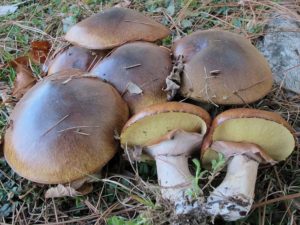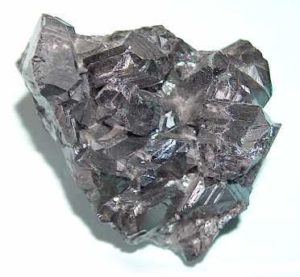
Hi Laura, congratulations on winning the Fungal Biology and Biotechnology student prize. Could you give us some background information concerning your project and explain why it is important to understand how fungi adapt to xenobiotics?

Thank you. I am very grateful to the editors and judges for this singular honour. It is a nice appreciation of my work. I am currently working with the ectomycorrhizal Basidiomycete Suillus luteus, which is a common and indigenous fungal symbiont of pine trees in our area (Belgium).
We found S. luteus isolates that were capable to survive and thrive on soils severely polluted with heavy metals. In vitro screenings revealed that S. luteus developed isolates adapted to high concentrations of zinc (Zn), cadmium (Cd) or copper (Cu).
My PhD research focuses on the investigation of the Zn tolerant isolates of S. luteus as it has already been shown that these isolates are capable to protect their host plants from metal stress. This feature makes them interesting candidates for use in phytostabilisation applications.
So here is already a first answer why it can be useful to study the adaptation to xenobiotics: microorganisms, including fungi, can be useful for environmentally friendly bioremediation purposes. Although mainly plant growth-promoting rhizobacteria are investigated for these purposes, fungi can be quite useful as well. Fungi play a very important role in the acquisition of nutrients in most plants.
Additionally, I also think studying how an organism adapts to xenobiotics is important since it can shed some light on evolutionary adaptation mechanisms. Many important questions about the genetic basis of adaptation remain unanswered.
Could you briefly describe your research on zinc transporters in Suillus luteus?

In a nutshell, the aim of my PhD is to elucidate the Zn tolerance mechanism in S. luteus. Previous data from our group suggested that transporter proteins play a crucial role in the tolerance.
Therefore my work focuses on the characterization of Zn transporters in S. luteus. I have already identified 7 CDF (Cation Diffusion Facilitator) and 4 ZIP (Zrt-, Irt- like Proteins) transporters in the genome of S. luteus. The CDF and ZIP transporter families govern most of the Zn transport in Eukaryotic cells.
One transporter in particular, SlZnT2, is very interesting as it was shown that Zn tolerance corresponded with a high SlZnT2 transcription level. This difference in gene expression is now further investigated. We use genome walking and qPCR (quantitative Polymerase Chain Reaction) to analyse the SlZnT2 promotor sequence and gene copy number.
What brought you to work with fungi? And what do you enjoy most about your research?
To be honest, in the beginning of my biology studies, I would never have considered to work with fungi. Fortunately we had an enthusiastic professor, Jan Colpaert, who teached us on the importance of fungi in terrestrial ecosystems.
We were amazed to learn that particular fungi were capable of forming symbiotic associations with plants. The professor introduced us to his work with ectomycorrhizal fungi and what can I say, his enthusiasm was contagious! Later on, I got the opportunity to do an internship for my master’s thesis on this interesting group of fungi and I liked it so much that I stayed on as a PhD student.

What I enjoy most about my research is that it is not a monotonous work. I learn and read a lot about different topics (ecology, mycorrhiza, molecular biology, genetics,…), in the lab I use a lot of different techniques and sometimes I also help with practical classes, which is very rewarding. So in general, my work as a PhD student is really versatile and I love it.
In the beginning of my PhD I was really impatient, I wanted to start and have results right away. Therefore the lab work sometimes felt too repetitive and even a bit boring. It seemed to take forever before I got my data. However, when I finally obtained my data and they looked good, it was all worth the effort. It is a really nice feeling getting your data and knowing you are making progress in your research. Now, I often have a lot of experiments running at the same time and I am happy with the repetitive work, because it helps me relax and clear my mind.
Last but not least, I also enjoy the small things. For example, when we have an isolate in our collection with a lot of contamination or one that stopped growing on the petri dish and I am able to “rescue” the isolate. Silly things, but they can put a smile on my face. Last week, I went to have a look at the Pine seedlings I am growing together with S. luteus. They developed beautiful mycorrhiza and I just had to take a picture of them.
Where would you like to see your research taking you in the next few years?
In the next few years, I hope to characterize more Zn transporters in S. luteus and demonstrate their role in the Zn tolerance. Hopefully this will enable me to unravel the molecular mechanism behind the Zn tolerance trait and help me to start developing a phytostabilization technique. I strongly believe this is a viable option, since it has already been demonstrated that these Zn adapted isolates of S. luteus protect their host pine trees from Zn stress.
Furthermore, I hope also to grow as a researcher, gaining more knowledge, learning new techniques and discussing further with other researchers in the field.
What advice would you give young scientists starting out in research?
 Well first of all, I think it is really important to study something that is fascinating to yourself. Get involved in research that is challenging. Yet, do not forget to take a step back from time to time, a healthy work-life balance is important as well.
Well first of all, I think it is really important to study something that is fascinating to yourself. Get involved in research that is challenging. Yet, do not forget to take a step back from time to time, a healthy work-life balance is important as well.
If possible, also find a nice PI. Someone who is willing to teach you, guide you, help you and reassure you. Having someone who takes time to discuss your work, gives you feedback and asks you a lot of questions, will boost your evolution as a researcher more than you would expect.
Furthermore, stay eager to learn and keep an open mind. If your results conflict with your hypothesis, don’t let this put you down! Although the scientific literature is dominated by positive results, negative results are part of life and should be published as well. Be prepared for obstacles. When reading articles you see all these nice data and figures and it may seem pretty straightforward. But rest assured that all of the optimization and trial and error that you will experience was experienced by others as well.
And in many cases a technique that works well in one species will not work with yours. In that case, do not be discouraged! See it as a learning experience, you mastered a new technical skill. Often the trick to thoroughly comprehend a technique is experiencing problems with it and consequently doing a lot of troubleshooting.
Finally I would also strongly encourage new researchers to ask questions. Ask a lot of questions and do not be intimidated by more senior researchers. After all, they were students once too.
Laura Coninx
Latest posts by Laura Coninx (see all)
- That zincing feeling – fungal adaptation to pollutants - 20th May 2016
Comments